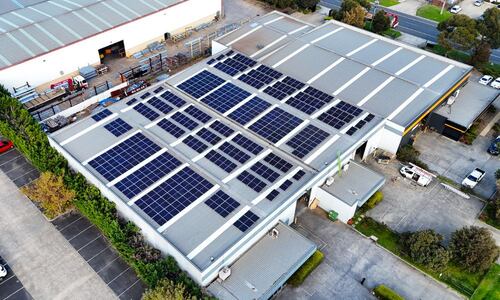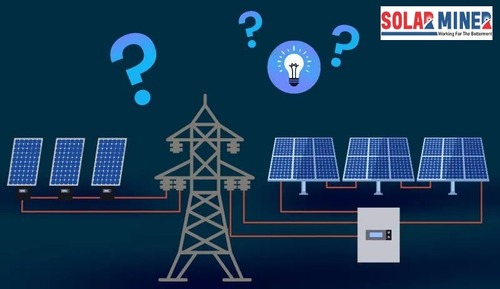Introduction to Commercial Solar Energy in Australia
Australia has become one of the universal leaders in solar energy adoption, and it’s no wonder that large commercial operations are at the forefront of this revolution. Businesses across sectors, from manufacturing to retail, are realizing the enormous financial and environmental benefits of solar power.
The commercial solar panel system industry in Australia is projected to grow by over 20% yearly through 2030. As companies’ goal to decrease operational costs and progress sustainability profiles, solar has become an important tactical investment rather than a luxury.
Installing a solar panel system for big commercial operations in Australia is a chief strategic investment, motivated by the nation’s plentiful sunshine and high energy costs. These large-scale systems (often $50kW and above) offer noteworthy savings on electricity bills and shield against energy price volatility for high-consumption businesses like factories, cold storage, and data centres.
Besides, commercial solar boosts a company’s Environmental, Social, and Governance (ESG) credentials, and the investment is made more financially attractive through Australian government incentives like Large-scale Generation Certificates (LGCs) and probable tax benefits. It is an established pathway to energy security and operational cost reduction.

Why Large Commercial Operations Are Switching to Solar in Australia?
Rising Electricity Costs and Business Challenges
Energy costs in Australia have seen a steady rise over the past decade. For large facilities that operate heavy machinery, air conditioning, or refrigeration systems, power bills can consume a noteworthy chunk of operating expenses. A well-made solar panel system benefits by stabilising costs and providing expected long-term energy pricing.
Environmental Responsibility and Corporate Sustainability Goals
With increasing public and governmental weight for sustainable applies, several Australian businesses have united renewable energy targets into their commercial strategies. Solar energy straight supports carbon neutrality goals, dipping greenhouse gas emissions while enhancing brand reputation.
Benefits of Commercial Solar Panel Systems
For large commercial operations, capitalizing on a solar panel system is a commanding financial and strategic choice. These businesses, which have high daytime energy demands and expansive rooftop space, are faultlessly positioned to produce substantial amounts of their own electricity.
The chief benefit is a dramatic decrease in monthly operating costs, providing a vital shield against impulsive and rising grid electricity prices. Beyond the bottom line, accepting solar reveals a commitment to Environmental, Social, and Governance (ESG) goals, meaningfully enhancing brand reputation with customers and stakeholders.
Lastly, government tax incentives and subsidies often make the preliminary capital expenditure decidedly attractive, ensuring a strong, rapid return on investment (ROI) that endures for decades.

Long-Term Cost Savings and ROI
Installing solar panels intensely decreases electricity bills, with distinctive savings ranging from 40% to 70% depending on system size and energy usage. Over time, these savings can interpret to millions of dollars for big operations.
Energy Independence and Reliability
Solar energy safeguards businesses from grid instability and rising utility rates. When balancing with battery storage, commercial solar systems can deliver near-total independence from the grid, particularly beneficial during power outages or the highest demand hours.
Government Incentives and Tax Benefits
Australia’s federal and state governments propose plentiful incentives, such as the Small-Scale Technology Certificates (STCs) and Large-Scale Generation Certificates (LGCs), which lower upfront costs and provide a higher return on investment.
Key Components of a Large Commercial Solar System
Solar Panels
The heart of every system, solar panels convert sunlight into electricity. For commercial setups, monocrystalline and bifacial panels are chosen for their high competence and durability.
Inverters
Inverters transform DC power from solar panels into serviceable AC power. Commercial systems naturally use string inverters or central inverters, reliant on the project’s scale.
Battery Storage Systems
With energy storage, businesses can store surplus power produced during the day and use it during crowning hours or at night, maximizing effectiveness and dipping dependence on the grid.
Monitoring and Maintenance Tools
Smart monitoring platforms permit businesses to pathway energy generation and system performance in real-time, helping optimise energy usage and perceive issues early.
Factors to Consider Before Installation
Before investing in a solar panel system, businesses should appraise:
- Roof space and orientation: Perfect roofs face north in Australia and have minimal shading.
- Energy consumption: Analyze historical electricity practice to regulate system capacity.
- Scalability: Select systems that can be increased as business operations grow.
The Solar Installation Process Explained
Initial Consultation and Feasibility Study
Specialists measure your site, energy requirements, and possible solar output using advanced software modeling.
Design, Approval, and Installation
After engineering sanction, installation takes place with negligible distraction to daily operations.
System Testing and Commissioning
Post-installation, technicians accomplish testing to safeguard ideal performance and compliance with Australian standards.
Commercial Solar System Costs in Australia
Average Price per kW
As of 2025, large commercial systems cost between $700 – $1,200 per kW, depending on size and technology. (Note: Consult your vendor for the best price)
Cost Variables
- Location and solar irradiance
- Brand and efficiency of panels
- Inclusion of batteries or monitoring software
Return on Investment (ROI) Analysis
Payback Period Estimates
Most large commercial systems attain a payback period of 3–6 years, after which the electricity cost is nearly free for the residue of the system’s 25-year lifespan.
Financial Modelling Example
A 500 kW solar system costing $500,000 could save around $90,000 per year, yielding ROI within five years. (Note: Consult your vendor for the best price)
Maintenance and Monitoring for Large Systems
Steady maintenance confirms topmost performance. Distinctive preservation comprises cleaning panels, checking wiring, and monitoring output. Cloud-based platforms like Solar Analytics or Fronius Solar.web enable automated system performance alerts.
Real-World Case Studies
Solar-Powered Manufacturing Plant
A Melbourne-based manufacturing firm installed a 750 kW solar system and reduced yearly energy bills by 60%, cutting carbon emissions by 400 tons.
Large-Scale Retail Operations
A retail chain in Melbourne organized rooftop solar across 20 stores, together saving over $1.5 million annually in electricity costs.
Top Solar Panel Brands for Commercial Use in Australia
- SunPower – Premium efficiency and long warranties
- Trina Solar – Cost-effective and reliable
- Q CELLS – Excellent performance in Australian conditions
- JinkoSolar – Durable, large-scale solutions for industrial use
Future Trends in Commercial Solar Energy
- AI-driven energy optimisation
- Solar + Hydrogen hybrid systems
- Microgrids enabling distributed energy networks
These revolutions aptitude superior effectiveness, lower costs, and cleverer energy management.
FAQs
1. How much energy can a large commercial solar system generate?
A 500 kW system can generate roughly 2,000 kWh per day, depending on location and sunlight exposure.
2. What’s the lifespan of commercial solar panels?
Most high-quality panels last 25–30 years, with efficiency warranties up to 90% after 25 years.
3. Are solar systems suitable for all roof types?
Yes, solar mounting systems can be customised for flat, pitched, or even metal roofs.
4. Do commercial solar systems work on cloudy days?
Yes, though efficiency decreases slightly, modern panels can still generate power under diffused sunlight.
5. How often should solar systems be serviced?
Ideally, once or twice a year, cleaning and inspections maintain peak performance.
6. Can excess power be sold back to the grid?
Yes, through feed-in tariffs, businesses can earn credit for surplus electricity fed back to the grid.
In Conclusion:
Investing in a solar panel system for large commercial operations in Australia isn’t just an environmental decision; it’s a commanding financial strategy. With proven ROI, government incentives, and long-term sustainability benefits, solar energy empowers businesses to flourish in a greener, more energy-efficient future. Whether you operate a factory, warehouse, or retail chain, going solar today confirms lower costs, advanced resilience, and a happier tomorrow for your business and the planet.
